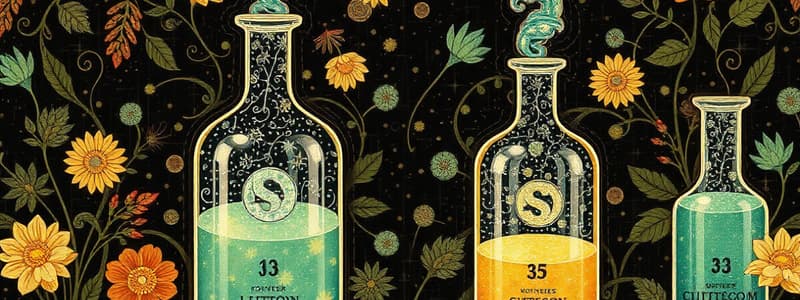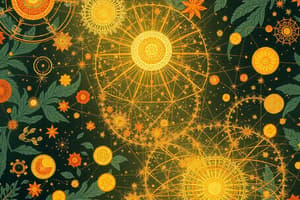Podcast
Questions and Answers
Which characteristic is NOT true about the melting and boiling points of ionic compounds?
Which characteristic is NOT true about the melting and boiling points of ionic compounds?
- They have low melting and boiling points. (correct)
- They are significantly affected by temperature.
- They remain stable under extreme temperatures.
- They possess high melting and boiling points.
Which type of chemical reaction involves the combination of two or more simple substances?
Which type of chemical reaction involves the combination of two or more simple substances?
- Combustion
- Single Displacement
- Synthesis (correct)
- Decomposition
What is the reason ionic compounds can conduct electricity when dissolved in solution?
What is the reason ionic compounds can conduct electricity when dissolved in solution?
- They form covalent bonds in solution.
- They precipitate out of the solution.
- They release electrons into the solution.
- They produce free-moving ions. (correct)
Which statement about covalent compounds is accurate?
Which statement about covalent compounds is accurate?
Which of the following best describes the role of subscripts in chemical formulas?
Which of the following best describes the role of subscripts in chemical formulas?
Which of the following is a defining characteristic of a double displacement reaction?
Which of the following is a defining characteristic of a double displacement reaction?
Which of the following substances would qualify as an acid based on its properties?
Which of the following substances would qualify as an acid based on its properties?
What property of ionic bonds contributes to the high melting and boiling points of ionic compounds?
What property of ionic bonds contributes to the high melting and boiling points of ionic compounds?
What percentage of energy is typically transferred to secondary consumers?
What percentage of energy is typically transferred to secondary consumers?
Which of the following best describes biomagnification?
Which of the following best describes biomagnification?
Which factor is considered a density-independent limiting factor?
Which factor is considered a density-independent limiting factor?
What is the main consequence of a trophic cascade involving the removal of top predators?
What is the main consequence of a trophic cascade involving the removal of top predators?
Which statement is true regarding tertiary consumers?
Which statement is true regarding tertiary consumers?
How does the Second Law of Thermodynamics relate to energy transfer in ecosystems?
How does the Second Law of Thermodynamics relate to energy transfer in ecosystems?
In the context of ecosystems, carrying capacity refers to?
In the context of ecosystems, carrying capacity refers to?
Which animals are primarily studied in the predator-prey dynamics on Isle Royale?
Which animals are primarily studied in the predator-prey dynamics on Isle Royale?
What effect does the removal of wolves have on the moose population?
What effect does the removal of wolves have on the moose population?
Which statement best describes biodiversity?
Which statement best describes biodiversity?
Which of the following best distinguishes biotic factors from abiotic factors?
Which of the following best distinguishes biotic factors from abiotic factors?
How does bioaccumulation differ from biomagnification?
How does bioaccumulation differ from biomagnification?
What characteristic is associated with Japanese knotweed?
What characteristic is associated with Japanese knotweed?
Which factor primarily affects the potential spread of Japanese knotweed with climate change?
Which factor primarily affects the potential spread of Japanese knotweed with climate change?
What impact does high biodiversity have on ecosystems?
What impact does high biodiversity have on ecosystems?
What is a significant characteristic of bioaccumulation?
What is a significant characteristic of bioaccumulation?
What feature of Japanese knotweed contributes to stream bank instability?
What feature of Japanese knotweed contributes to stream bank instability?
Which of the following describes a characteristic of Japanese knotweed?
Which of the following describes a characteristic of Japanese knotweed?
What is the significance of Japanese knotweed's allelopathic properties?
What is the significance of Japanese knotweed's allelopathic properties?
Where is Japanese knotweed NOT found in Canada?
Where is Japanese knotweed NOT found in Canada?
How does the time interval (Δt) relate to an object's motion?
How does the time interval (Δt) relate to an object's motion?
Displacement (Δx) measures what aspect of motion?
Displacement (Δx) measures what aspect of motion?
What distinguishes a vector from a scalar?
What distinguishes a vector from a scalar?
Which statement about the origin in motion is accurate?
Which statement about the origin in motion is accurate?
Which of the following statements is true regarding monatomic and diatomic elements?
Which of the following statements is true regarding monatomic and diatomic elements?
How are ionic bonds formed between atoms?
How are ionic bonds formed between atoms?
What characterizes a heterogeneous mixture?
What characterizes a heterogeneous mixture?
Which of the following pairs correctly describes cations and anions?
Which of the following pairs correctly describes cations and anions?
What type of compound is formed through the sharing of electrons?
What type of compound is formed through the sharing of electrons?
How are polyatomic elements defined?
How are polyatomic elements defined?
Which of the following examples is a common ionic compound?
Which of the following examples is a common ionic compound?
What distinguishes homogeneous mixtures from heterogeneous mixtures?
What distinguishes homogeneous mixtures from heterogeneous mixtures?
What is the correct formula for calculating velocity?
What is the correct formula for calculating velocity?
Which statement correctly describes momentum?
Which statement correctly describes momentum?
What would be the net force acting on a 5 kg object accelerating at 3 m/s²?
What would be the net force acting on a 5 kg object accelerating at 3 m/s²?
Which of the following describes the concept of impulse?
Which of the following describes the concept of impulse?
What represents normal force in physics?
What represents normal force in physics?
If an object experiences a change in momentum of 20 kg/m/s due to a force of 5 N applied over time, what is the time interval?
If an object experiences a change in momentum of 20 kg/m/s due to a force of 5 N applied over time, what is the time interval?
According to Newton's First Law, which scenario exemplifies inertia?
According to Newton's First Law, which scenario exemplifies inertia?
What is the gravitational force exerted on a 10 kg mass?
What is the gravitational force exerted on a 10 kg mass?
Flashcards
What is matter?
What is matter?
Anything that has mass and occupies space. It exists in three states: solid, liquid, and gas. It is made up of atoms, which are the basic units of elements.
What is an element?
What is an element?
A pure substance made of only one type of atom. They are organized in the periodic table.
What are monatomic elements?
What are monatomic elements?
Elements that exist as single atoms, like helium (He) or argon (Ar).
What are diatomic elements?
What are diatomic elements?
Signup and view all the flashcards
What are polyatomic elements?
What are polyatomic elements?
Signup and view all the flashcards
What is a compound?
What is a compound?
Signup and view all the flashcards
What are ionic compounds?
What are ionic compounds?
Signup and view all the flashcards
What are molecular compounds?
What are molecular compounds?
Signup and view all the flashcards
Secondary Consumers (Carnivores)
Secondary Consumers (Carnivores)
Signup and view all the flashcards
Tertiary Consumers (Top Carnivores)
Tertiary Consumers (Top Carnivores)
Signup and view all the flashcards
Energy Transfer in Food Chains
Energy Transfer in Food Chains
Signup and view all the flashcards
Biomagnification
Biomagnification
Signup and view all the flashcards
Limiting Factors
Limiting Factors
Signup and view all the flashcards
Carrying Capacity
Carrying Capacity
Signup and view all the flashcards
Trophic Cascade
Trophic Cascade
Signup and view all the flashcards
Isle Royale Wolves and Moose
Isle Royale Wolves and Moose
Signup and view all the flashcards
What are polyatomic ions?
What are polyatomic ions?
Signup and view all the flashcards
What is a property of covalent compounds?
What is a property of covalent compounds?
Signup and view all the flashcards
Why do ionic compounds conduct electricity in solutions?
Why do ionic compounds conduct electricity in solutions?
Signup and view all the flashcards
Why are ionic bonds strong?
Why are ionic bonds strong?
Signup and view all the flashcards
What is the 'Law of Conservation of Mass'?
What is the 'Law of Conservation of Mass'?
Signup and view all the flashcards
What do coefficients in a chemical equation represent?
What do coefficients in a chemical equation represent?
Signup and view all the flashcards
What are acids?
What are acids?
Signup and view all the flashcards
What is a synthesis reaction?
What is a synthesis reaction?
Signup and view all the flashcards
Biodiversity
Biodiversity
Signup and view all the flashcards
Bioaccumulation
Bioaccumulation
Signup and view all the flashcards
Biotic Factors
Biotic Factors
Signup and view all the flashcards
Abiotic Factors
Abiotic Factors
Signup and view all the flashcards
Ecological Balance
Ecological Balance
Signup and view all the flashcards
Japanese Knotweed
Japanese Knotweed
Signup and view all the flashcards
Bioaccumulation
Bioaccumulation
Signup and view all the flashcards
Ecosystem Stability
Ecosystem Stability
Signup and view all the flashcards
Position (x)
Position (x)
Signup and view all the flashcards
Origin
Origin
Signup and view all the flashcards
Vector
Vector
Signup and view all the flashcards
Scalar
Scalar
Signup and view all the flashcards
Time Interval (Δt)
Time Interval (Δt)
Signup and view all the flashcards
Displacement (Δx)
Displacement (Δx)
Signup and view all the flashcards
Allelopathic Properties
Allelopathic Properties
Signup and view all the flashcards
Speed
Speed
Signup and view all the flashcards
Velocity
Velocity
Signup and view all the flashcards
Momentum
Momentum
Signup and view all the flashcards
Acceleration
Acceleration
Signup and view all the flashcards
Gravity
Gravity
Signup and view all the flashcards
Normal Force
Normal Force
Signup and view all the flashcards
Net Force
Net Force
Signup and view all the flashcards
Impulse
Impulse
Signup and view all the flashcards
Study Notes
Matter
- Matter is anything that has mass and occupies space.
- Matter exists in three states: solid, liquid, and gas.
- The basic unit of matter is atoms.
- Atoms form molecules, which form the building and composing units of elements
Elements
- An element is a pure substance made of one type of atom.
- Elements are organized in the periodic table.
- Elements can be classified as:
- Monatomic elements: single atoms (e.g., helium, argon)
- Diatomic elements: pairs of atoms (e.g., hydrogen, oxygen, nitrogen)
- Polyatomic elements: more than two atoms (e.g., phosphorus, sulfur)
Compounds
- A compound is a substance formed when two or more elements chemically bond together.
- Compounds can be classified as:
- Ionic compounds: formed from positively charged ions (cations) and negatively charged ions (anions) held together by ionic bonds (e.g., sodium chloride, magnesium oxide).
- Molecular compounds: formed from atoms held together by covalent bonds, where atoms share electrons (e.g., water, carbon dioxide).
Ionic Bonds
- Ionic bonds form when electrons are transferred between atoms, creating oppositely charged ions that attract each other.
- This type of bond typically forms between metals and nonmetals.
- Ionic compounds typically have high melting and boiling points.
Molecular Compounds
- Molecular compounds are formed when atoms share electrons through covalent bonds.
- These compounds can be gases, liquids, or solids (e.g., carbon monoxide, methane).
Mixtures
- A mixture is a combination of two or more substances that are not chemically bonded.
- Mixtures can be:
- Heterogeneous: Components are not uniformly distributed, and different parts can be seen (e.g., salad, soil).
- Homogeneous: Components are uniformly distributed, appearing as a single substance (e.g., air, saltwater).
Cations and Anions
- Cations: Positively charged ions (formed when an atom loses electrons).
- Anions: Negatively charged ions (formed when an atom gains electrons).
Polyatomic Ions
- Polyatomic ions are ions composed of more than one atom.
Properties of Covalent Compounds
- Generally have low melting and boiling points.
- Do not conduct electricity in solution.
- Usually soluble in nonpolar solvents, insoluble in water.
Properties of Ionic Compounds
- High melting and boiling points.
- Conduct electricity when dissolved in water or molten (due to free-moving ions).
- Tend to be brittle.
Ionic Compounds Conduct Electricity
- When dissolved in water or melted, ions are free to move, allowing the compound to conduct electricity.
Balancing Chemical Equations
- The total number of atoms on both sides of a chemical equation must be equal to follow the Law of Conservation of Mass.
- Subscripts in a formula show the number of atoms of each element in a molecule.
Types of Chemical Reactions
- Synthesis: Combining simple substances into a more complex one.
- Decomposition: Breaking down a complex substance into simpler ones.
- Single Displacement: One element replacing another in a compound.
- Double Displacement: The ions of two compounds exchange places.
- Combustion: Reacting with oxygen, releasing energy
Studying That Suits You
Use AI to generate personalized quizzes and flashcards to suit your learning preferences.




